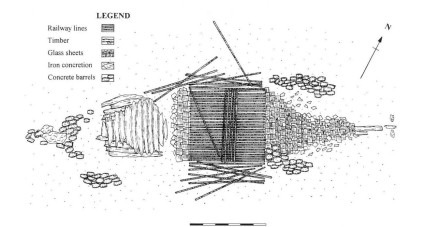History
Foundered near the Isle of Wight
The Fenna was a two-masted Dutch schooner, built in 1862 and owned by J. A. Hooites and T. A. Hoviks (an important shipowner). It foundered off the Isle of Wight on the 10th of March 1881 while en-route from Amsterdam to Messina and Trieste in the Mediterranean. The Fenna is recorded as carrying a cargo of iron products and glass sheets. The fullest account of the ship’s sinking is from a local Bournemouth newspaper report. This reports that following heavy gales the ship began to take on water, upon which he crew decided to abandon the vessel, which foundered off the Dorset coast. The crew and skipper were able to save themselves by rowing to Poole. The Lloyds List account of the sinking records that it foundered 24 miles off the Needles before drifting and sinking. It also mentions that after the sinking, the mastheads of the vessel could still be seen above the surface, thus posing a danger to navigation. From the upright position, it can be assumed that the sea was fairly calm when the vessel actually sank.

As a vessel type, schooners played an increasingly important role in the facilitation of maritime trade in Northern Europe during the 18th and 19th century. Around 3000 such vessels are listed in the National Monuments Record as being lost in English waters alone, prior to 1901. Of these, only 24 vessels, including the Fenna, are of Dutch origin.

Research and identification
The wrecksite was first noted by the UK Hydrographic Office (UKHO) in 1981 during soundings in the area. It was examined again in 1988 using an echosounder, when it was concluded that it was a small wreck or obstruction. The site was first dived on in 2000 by Dave Wendes (of Wight Spirit Charters). He informed the Hampshire and Wight Trust for Maritime Archaeology of the discovery of a shipwreck, which subsequently conducted a baseline survey remains in July 2002.
The site under assessment comprises the remains of a shipwreck, lying upright on the seafloor west of the Needles. The cargo of railway lines, glass sheets and concreted material formerly contained in wooden barrels is exceptionally well-preserved and remains stacked in-situ on the seafloor.
Ongoing research into the site, by both the Maritime Archaeology Trust (MAT) and Wendes has concluded that it concerns the remains of the Fenna. The identification is based on the correlation between the location and nature of the wreck with the known history of the Fenna, in particular with the cargo as it is known from the cargo manifest of the Fenna.
Description
Rigging: two-mast schooner
Yard: probably a yard in Hoogezand, the Netherlands
Owner: J. A. Hooites T. A. Hoviks
The ship was registered in Amsterdam and built for J.A. Hooites

| Master | Mulder, J.H. |
|---|---|
| People on board | 6 |
| Tonnage | 172 ton |
Status
It can be concluded that the Fenna is a very rare site that exhibits a very high level of preservation and the site also has a high potential for future research. As such, the site of the Fenna should be considered of high significance with the UK's corpus of historic shipwreck remains.
The wreck measures 30 meters in length by ca. 10 meters in width at the widest point. The vessel still sits upright on the seafloor in 18 metres of water, although parts of the hull of the vessel above the seabed have now degraded away. Although the upper elements of the wooden hull have disappeared, parts of the lower hull of the vessel are preserved. It is likely that the lower part of the hull is preserved beneath the cargo. An anchor chain, indicating the bow, remains at the south-western end of the wreck. Copper nails, probably used in the hull construction, ar found along the edges of the site.
It lies on a flat gravel and sand seabed and it forms an oasis for marine life. The site plays the role of a reef, within an otherwise featureless seabed.

References
- Maritime Archaeology Trust.
Fenna.